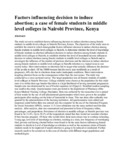| dc.description.abstract | The study set out to establish factors influencing decision to induce abortion among female students in middle level colleges in Nairobi Province, Kenya. The objectives of the study were to establish the extent to which demographic factors influence decision to induce abortion among female students in middle level colleges in Nairobi, to determine whether the level of knowledge of female students on abortion influences decision to induce abortion among female students in middle level colleges in Nairobi, to establish whether the level of household income influences decision to induce abortion among female students in middle level colleges in Nairobi and to investigate the influence of the number of previous abortions and the decision to induce abortion among female students in middle level colleges in Nairobi Abortion is a topical issue in our society today. Most interventions on abortions fail to target what actually influences the decision of the youths to abort. Of the 50000 women that die every year worldwide as a result of pregnancy, 40% die due to abortions done under inadequate conditions. Most interventions targeting abortion focus on the consequences rather than the root causes.
The study was conducted as a cross sectional survey. The target population was all female students of middle level colleges in Nairobi Province. College students were chosen as the population for this study since it is within their age bracket that there is a high likelihood of having unwanted pregnancies. Sample size was determined by use of Fischer equation (n=Z2pq/e2). Stratified random sampling was used in this study. Questionnaires were pre-tested at the department of Pharmacy ofthe Kenya Medical Training College, Machakos.
Data was collected by the researcher over a period of four weeks by the use of self administered questionnaires which were given to the sampled participants after reading out the letter of transmittal to them. This was done after authority was granted by the administration of the learning institution.
All questionnaires were edited and responses coded before data was entered into the computer by the use of the Statistical Program for Social Scientists (SPSS), version 11.5.Cross tabulation was the main method used for data analysis. After analysis, data was summarised and presented in form of frequency tables, percentages, and proportions.
Prevalence of abortion in meddle colleges in Nairobi province was found to be 21.4%. Up to 59.2% of the respondents stated that they would not consider abortion if they became pregnant.
Of those who would abort, their main reason was to continue schooling. Young age, low level of knowledge on abortion, residing in a slum, low frequency of worshiping God, poverty and having aborted before were found to be the main factors influencing female students to decide to Level of knowledge on abortion as well as the economic status of female students needs to be improved if unsafe abortion is going to be reduced or eradicated. Further research needs to be carried out in this area of abortion with different target populations and methodologies. | en_US |

